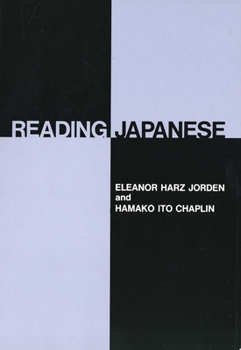Reading Japanese
Select Format
Select Condition 
Book Overview
This text presents a thorough introduction to the modern written language of Japan. It introduces 425 kanji characters.
Format:Paperback
Language:English
ISBN:0300019130
ISBN13:9780300019131
Release Date:September 1976
Publisher:Yale University Press
Length:613 Pages
Weight:2.38 lbs.
Dimensions:1.4" x 6.9" x 9.9"
Grade Range:Grades 10 to 12
Customer Reviews
4 ratings
Honestly, the best book for learning kanji.
Published by Thriftbooks.com User , 22 years ago
In common with other reviewers ot this book, I have a great collection of books for learning Japanese, and this is simply the best for learning (reading, writing, and remembering) Kanji.Of course, it was of great help that I had already a previous knowledge of the language (vocabulary, grammar, hiragana, katakana, etc.), so I just could focus in learning kanji.The advantages of this book are: 1) there is a constant repetition of the kanji already learned and 2) what is much more important: only kanji that have been dealt with are used in the examples and the reading material (and this feature, believe me, is unique to this book and makes it stand above the rest of the books for learning kanji, where the example sentences use kanji that you do not know how to read or their meaning, rendering these books unusable for the proposed task). So, if you want to avoid for yourself the suffering that others (including myself) have gone through, buy this book and forget about the rest.
The best $30 spent on a Japanese text yet
Published by Thriftbooks.com User , 22 years ago
Of all the Kanji related books I've purchased over the last four years since I began studying Japanese, this book is without question the single, most useful reference I've come across. The Kanji are presented one at a time, with its reading and its meaning, and then example phrases and sentences are given. Most importantly, these Kanji resurface over and over again as you progress through the book, making you learn through repetition. If you're looking for a firm foothold on the slippery slope of learning Kanji, start with this book.
Absolutely the best book for beginning kanji
Published by Thriftbooks.com User , 23 years ago
Although there are plenty of mnemonic systems to learn kanji, such as Heisig's "Remembering the Kanji" and Rowley's excellent "Kanji Pict-o-grafix", this is by far the best way to RETAIN the characters, and to actually read - instead of visually decode them. The examples following each kanji are numerous and include varying levels of formality, and are mixed male and female responses. This makes for excellent cross-study, and further reinforces the varietous ways in which kanji are used in Japanese writing. I would suggest the Heisig or Rowley to supplement this book, as both of those two employ a system which breaks down kanji into its 'radicals', which is very useful for trying to visually decipher new characters, but for sheer drills and practice, this is the only way to go. I am on my second copy of this text, as the first one was totally worn out, which by itself makes quite a strong statement - that didn't even happen to my school-assigned Japanese textbooks!
Excellent
Published by Thriftbooks.com User , 24 years ago
This is really the best book for learning to read Japanese. The book certainly doesn't teach the grammar. But the Kanji characters are introduced in small chunks at a time and literally drilled into the head by the exercises. The authors have also included the texts in hand-written Japanese which is very useful.I have only one complaint about this book - It does assume a knowledge of the authors' "Beginning Japanese". Not having read that book, I found the transliteration of the Kanji characters to be quite odd. For example, the authors have used "h" for "f" etc. So, unless a dictionary or teacher is consulted, the student is bound to make mistakes. It may not be fully suited for self-study.





